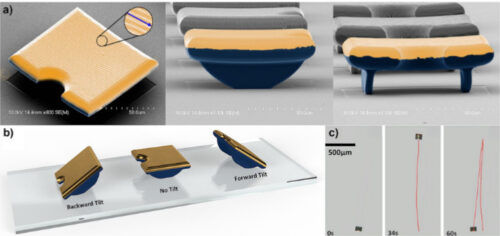すべてのFBOTの観測結果と完全に一致する初めてのモデル First model that is fully consistent with all FBOT observations
2022-04-20 ノースウェスタン大学
・ノースウェスタン大学の天体物理学の研究チームは、大胆な新解釈を提示しました。新しいモデルを用いて、FBOT は、死にかけた星が放出するジェットを取り囲む繭が活発に冷却されることによって発生する可能性があると考えています。これは、FBOTに関連するすべての観測と完全に一致する初めての天体物理学モデルです。
この研究成果は、4月11日発行の英国王立天文学会誌「マンスリー・ノーティス・オブ・ザ・ロイヤル・アストロノミカル・ソサエティ」に掲載されました。
<関連情報>
- https://news.northwestern.edu/stories/2022/04/dying-stars-cocoons-might-explain-fast-blue-optical-transients/
- https://academic.oup.com/mnras/advance-article/doi/10.1093/mnras/stac910/6566365?login=true
CCSNeのショックドジェットは、高速の青色光過渡現象の動力源となりうる。 Shocked jets in CCSNe can power the zoo of fast blue optical transients
Monthly Notices of the Royal Astronomical Society Published:11 April 2022
DOI:https://doi.org/10.1093/mnras/stac910

図1. 星が爆発し、相対論的なジェットが発生した後の構造を模式的に示したもの。ジェットによって恒星物質が衝撃を受け、繭が作られる。
Abstract
Evidence is mounting that recent multiwavelength detections of fast blue optical transients (FBOTs) in star-forming galaxies comprise a new class of transients, whose origin is yet to be understood. We show that hydrogen-rich collapsing stars that launch relativistic jets near the central engine can naturally explain the entire set of FBOT observables. The jet-star interaction forms a mildly-relativistic shocked jet (inner cocoon) component, which powers cooling emission that dominates the high velocity optical signal during the first few weeks, with a typical energy of ∼1050 − 1051 erg. During this time, the cocoon radial energy distribution implies that the optical lightcurve exhibits a fast decay of L∼∝t−2.4L∼∝t−2.4. After a few weeks, when the velocity of the emitting shell is ∼0.01 c, the cocoon becomes transparent, and the cooling envelope governs the emission. The interaction between the cocoon and the dense circumstellar winds generates synchrotron self-absorbed emission in the radio bands, featuring a steady rise on a month timescale. After a few months the relativistic outflow decelerates, enters the observer’s line of sight, and powers the peak of the radio lightcurve, which rapidly decays thereafter. The jet (and the inner cocoon) become optically thin to X-rays ∼ day after the collapse, allowing X-ray photons to diffuse from the central engine that launched the jet to the observer. Cocoon cooling emission is expected at higher volumetric rates than gamma-ray bursts (GRBs) by a factor of a few, similar to FBOTs. We rule out uncollimated outflows, however both GRB jets and failed collimated jets are compatible with all observables.



